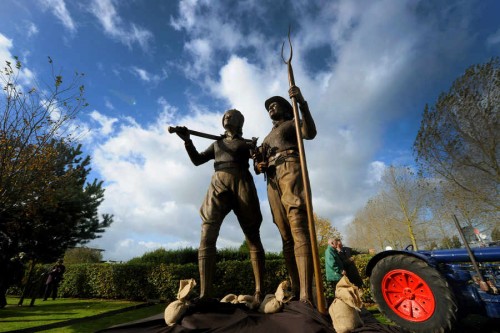
The Women’s Land Army statue at the National Memorial Arboretum
Older readers will recall that, by the 1970s, observance of the two minutes’ silence on 11/11 had declined in the civilian sphere to such an extent that a great many people paid no heed to it whatever and carried on doing whatever they were doing.
There’s been a big revival of observance in recent years.
In an article in The Times shortly before this year’s Remembrance events, Michael Binyon (Laurence was a cousin of his grandfather) asked questions likely to enrage many people who visit this blog. Are we, he asks, “in danger of becoming mawkish in sentimentalising the suffering of our grandparents and great-grandparents? Is Remembrance Sunday in danger of turning into a spectacle of synthetic emotion, paraded in a way that those who actually fought in two world wars would have found distasteful?”
Citing the Wootton Bassett phenomenon and the National Memorial Arboretum, Binyon suggests: “The danger is that we are creating something of a remembrance industry. There are, of course, historic injustices that can today be rectified: the “Shot at Dawn” memorial at the arboretum, for example, mirrors the quiet addition of names of men shot for cowardice to First World War memorials. But now there seems to be a passion to commemorate everything and anything. Dogs and donkeys and horses in the front line are getting their own memorials. Every region, factory or association that sent men to the front will be individually recognised. And to swell the number of those who actually fought, more and more auxiliaries are now included in the parades: nurses, doctors, ambulance drivers, mechanics, farmers and land girls — indeed, one could conceivably allow anyone who lived in wartime Britain to take part.”
You can read the whole of Binyon’s challenging article here(£)
Remembrance in Germany is, by contrast, more muted even than, possibly, you supposed. Barely 200 people turned up this year to honour the 1.7 million who died in the First World War and the 5.8 million who died in the Second World War. The act of remembrance was held this year on 16 November at Germany’s equivalent of the Cenotaph, the Neue Wache in Berlin (below), an austere former guardhouse containing an unknown soldier, an unknown concentration camp victim and a sculpture by Käthe Kollwitz titled Mother With Her Dead Son. Gebhardt von Moltke, a former ambassador to London, said: “It is a day of recollection and mourning but it is not a day of pride. In the UK the mourning is always related to pride. So you have a nation-building type of commemoration while we, with our history, commemorate the price we paid and all victims during the wars.” He did not attend.
[cycloneslider id=”neue-wach”]


Fasinating. So much a matter of personal preference, I guess, and a reminder that in our fragmented culture, we find it difficult to make appropriate public ceremony resonant to all. Just off the top edge of the bat: 1. remembrance sunday should be about members of the armed forces who died in and around battle. We need other forms of remembrance for nurses, doctors, horses etc. 2. The emphasis needs to be on soldiers who would still be alive had they not been killed. History can afford to be a little less intense and absolute. 3. Certainly we should remember… Read more »